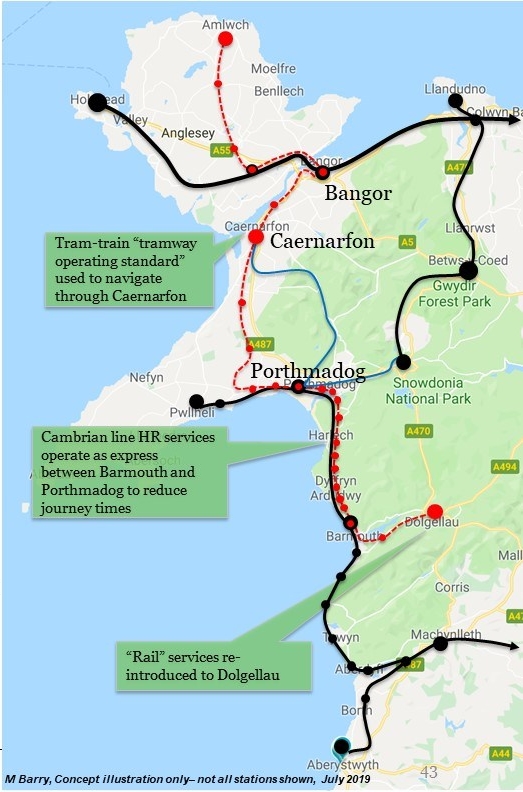
In June 2018, after a lengthy and innovative procurement process, Transport for Wales (TfW) awarded the Wales & Borders franchise for 2018-2033 to Keolis Amey. Much is promised – not least the South Wales Metro – and across Wales we can expect to see new trains, additional services, upgraded stations and a significant increase in overall capacity. Not as quick as some would like (it does take time to order, design, manufacture, and commission new rolling stock as well as designing and building a Metro!) but by 2023 we should really be experiencing a very different railway[i] Figure 1 Figure 2 Figure 3 .
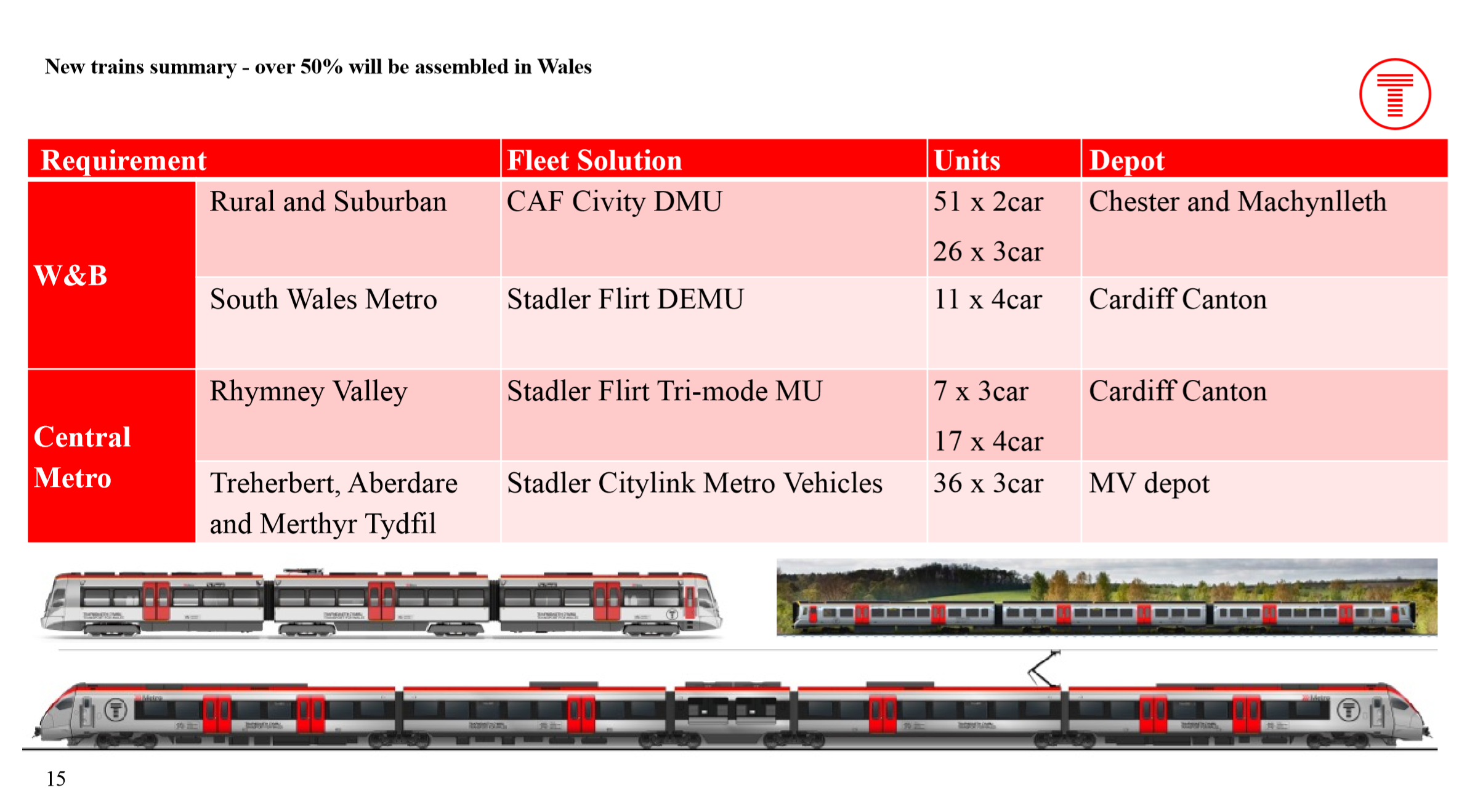
Figure 1 TfW Rail – New Train Summary
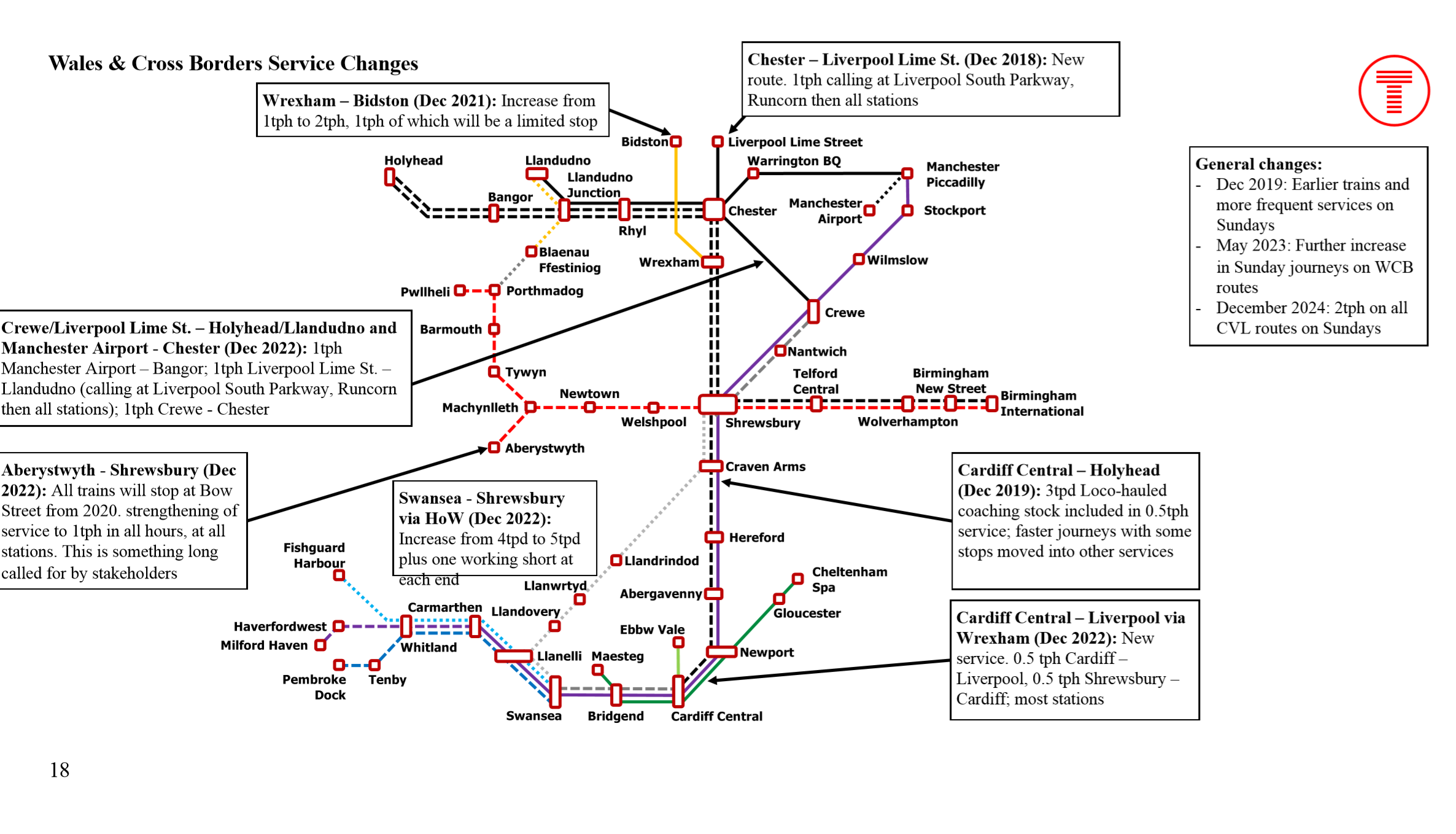
Figure 2 TfW Rail – New Rail Services Summary
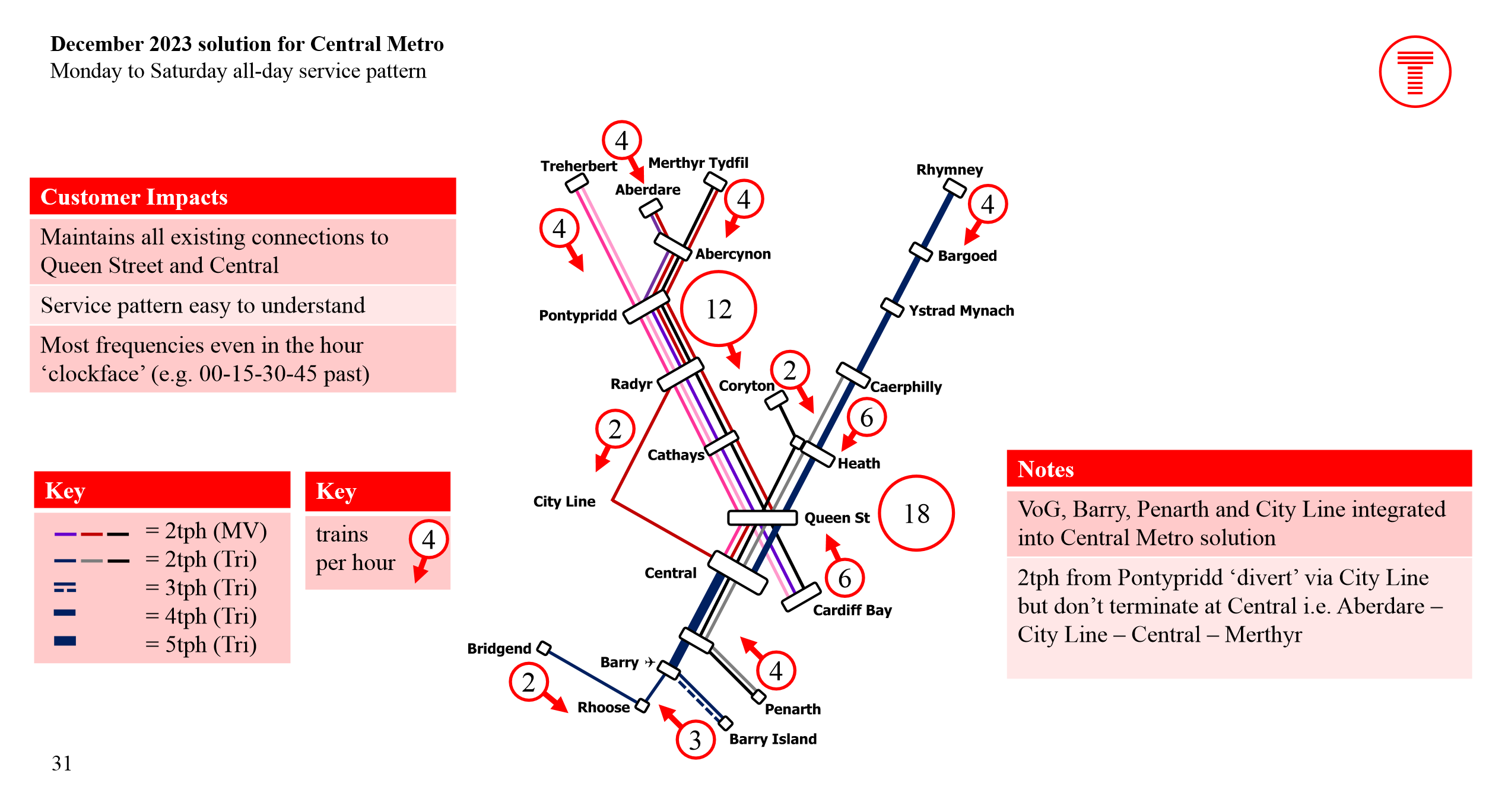
Figure 3 TfW Rail – proposed core Metro service patterns
I have written much about the South Wales Metro and its potential expansion [ii]and a little about Swansea. In this piece I want to explore what we can realistically aspire to in terms of the future development of Wales rail network in the west of the country and in particular north west Wales. These are not fully developed or costed proposals…. but they are interventions we can and should consider.
Underlying Challenges – Topology and Demography
Before I do, I want to set out a baseline. In general, Wales is hilly/mountainous Figure 4 which puts real constraints on where you can run/operate traditional Heavy Rail (HR) that is typical of the UK rail network managed by Network Rail (NR). Wales’ population is also not evenly distributed Figure 5 with few “large” cities and a concentration the south east. In fact, over half the Welsh population live within 30 miles of the centre of Cardiff!
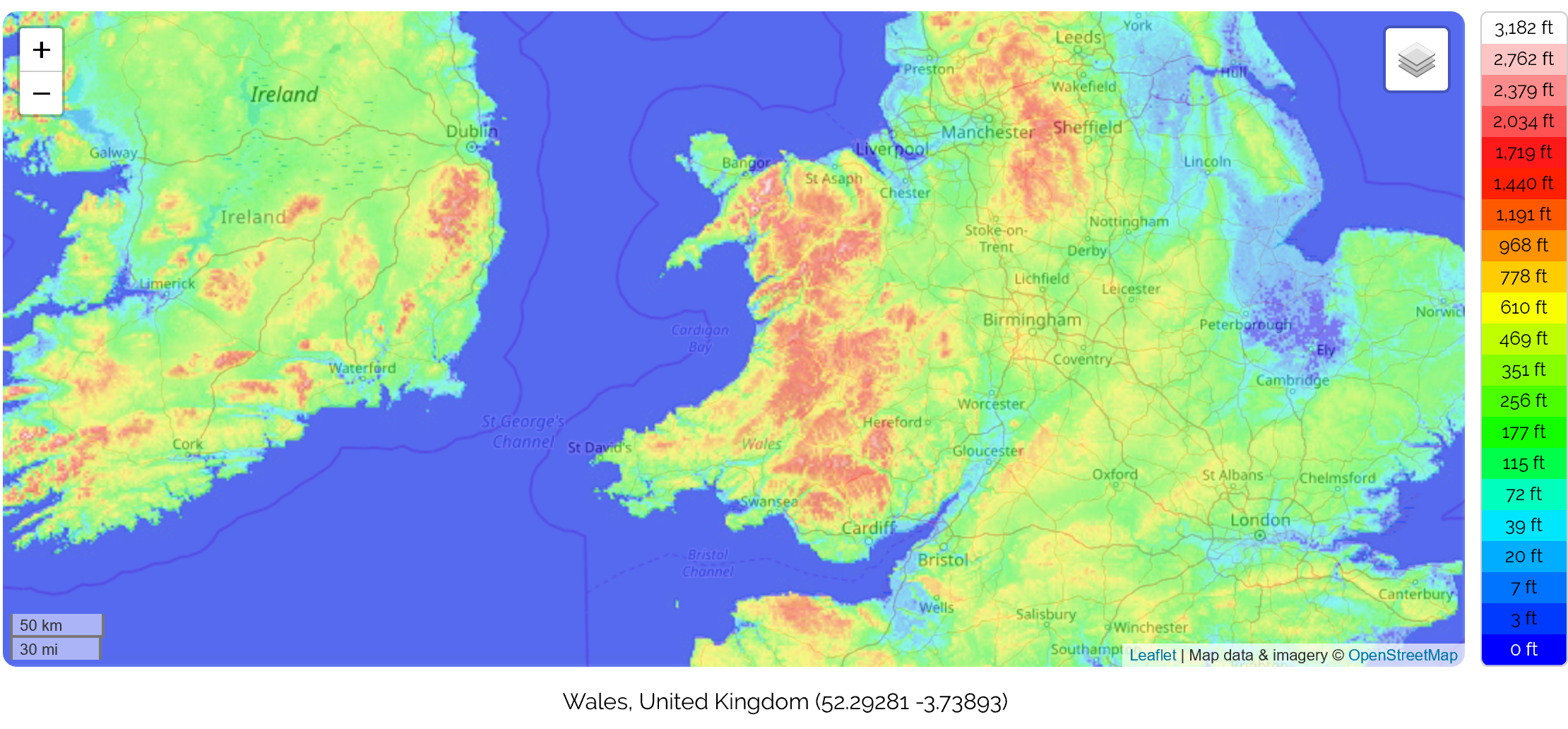
Figure 4 Wales Topography (from Topographic Maps[iii])
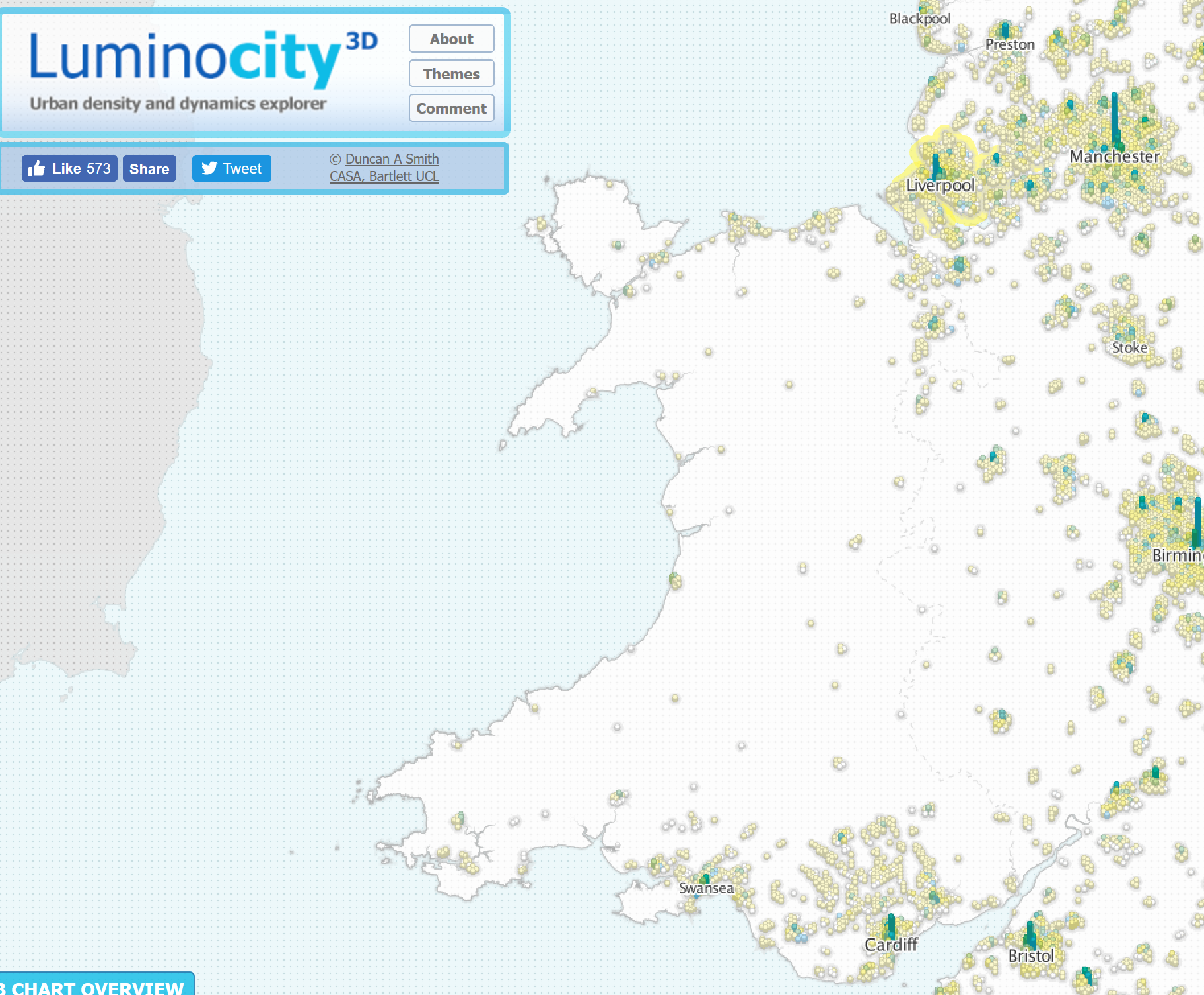
Figure 5 Wales Population & activity density (from Lumino City[iv])
UK Rail Standards
The development of the railways in the UK (and their technical specifications and standards) has been influenced more by the topology and demography of England than of Wales. England is less mountainous and has multiple large centres of population. This I assert, over decades, has influenced the design and operation of the railways. Whilst there are some variations and derogations what is in general use today for most commuting and long-distance services (excluding 125 mph High Speed services) is:
- Diesel or Electric Multiple Units capable of 70-100mph
- Used in sets of 2-6 units carrying up to 500 people and more typically in Wales 3 car sets holding about 200
- Rail track with a typical minimum curvature of at least 500M and elevations of a maximum of perhaps 3~4%
However, Wales is very different from England, given the smaller population centres (apart from Cardiff and Swansea) and a more challenging topology, which makes traditional HR more difficult to both build and operate (given the higher implicit subsidy requirements).
A different set of rail “standards” would perhaps, be more appropriate for some routes and corridors. I am not talking about the main lines across South Wales (SWML) and North Wales (NWML) or the Marches Line, which connect to England; but potential new and lost routes which may be better served with a different approach. We have seen this manifest in the many narrow-gauge railways that operate mainly on a tourist basis in Wales.
To illustrate the point, we can look at recent cases to re-open old routes; these inevitably struggle in my view because of an approach constrained by adopting costly UK HR standards; Aberystwyth – Carmarthen is a case in point.
We also have to step back and not look to just “re-open” old lines just for the sake of it; perhaps a new standard will enable a new approach and different route/alignment options which may have a more deliverable commercial profile.
Cars still dominate our mobility
There is another harsh reality to face when dealing with transport. Across Wales, most of us commute in cars; in fact in 2017 Figure 6 over 80% of us used cars with only 4% on train and another 4% on bus. In north east Wales the level of car use is likely to be a little higher given the more dispersed population. To begin to find viable alternative to the car – and bus and rail will be key – we have to be a little more innovative, especially as regards rail solutions.
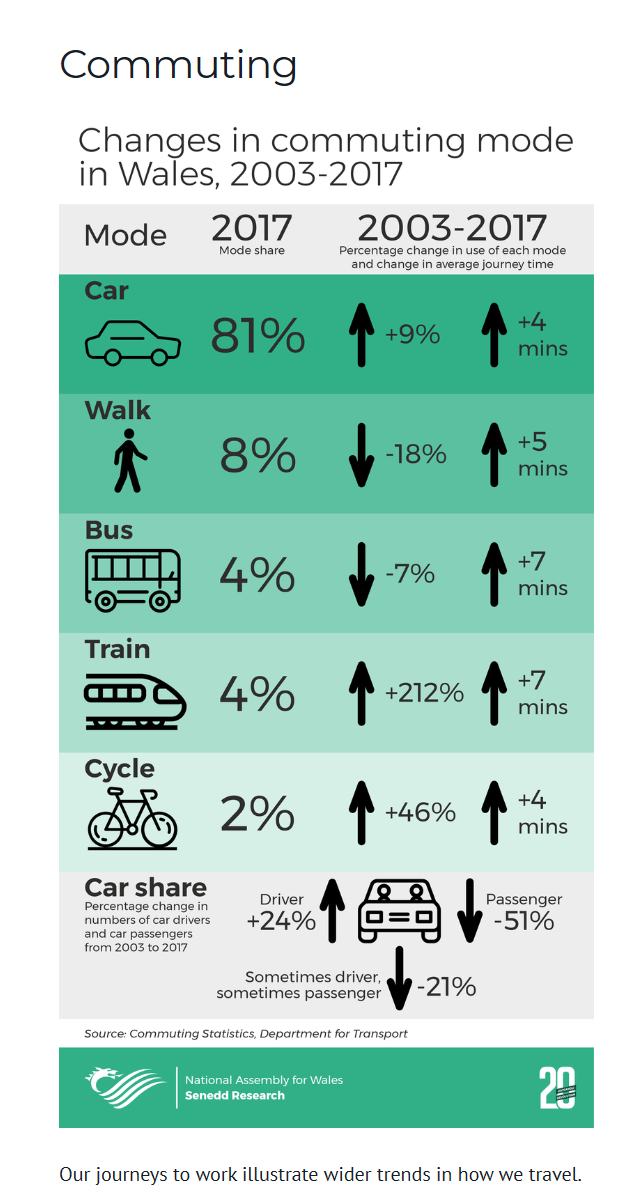
Figure 6 Welsh Gov, 2017 Mode Share in Wales for Commuting
We also need to reduce the impacts of the long-term induced demand for car usage which is damaging our environment. I covered some of these issues in my article on Transit Oriented Development in the Cardiff Capital Region[v] earlier in 2019.
The Tram-train Opportunity
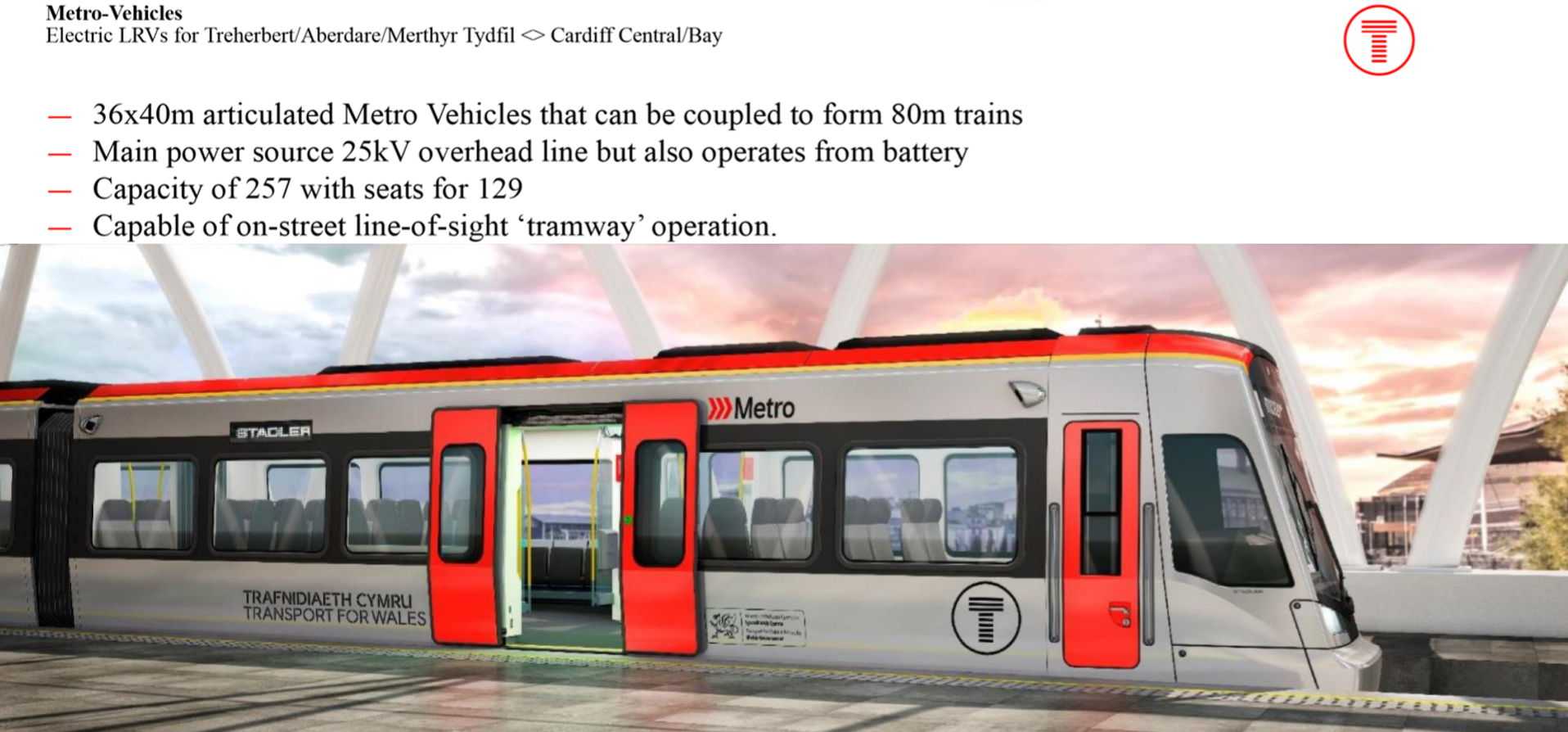
Figure 7 City Link Light Rail Tram-train “Metro Vehicles”
Given this baseline, I think a further development of the tram-train capability being delivered for the South Wales Metro may present perhaps unexpected opportunities elsewhere in Wales.
The contracted solution from TfW Rail for the South Wales Metro enables both network and service extensions through the application of tram-trains which allows more cost and engineering flexibility than is possible with a pure Heavy Rail solution. They can operate on tighter curves (down to 30M radius), steeper gradients (perhaps up to 8%), require shorter passing loops as well running “on-street” and operating to Line of Sight “tramway” protocols. In theory they also present the opportunity for lower operating costs. In summary tram-trains can go places traditional HR cannot.
It must be possible (again I assert) to develop a variant of this South Wales Metro Tram train that is designed for longer journeys. So, it would have perhaps more seats, toilets, etc. It may also have different traction power options – even diesel (and Stadler do manufacture a diesel tram-train[vi] ). The most important feature is the ability of tram train: to manage tighter curves and steeper gradients and to operate on traditional Network Rail HR as well as to tramway “on street” standards.
This then may present options for different rail based solutions in other parts of Wales. I certainly think there is an opportunity in Swansea Bay and north east Wales. I also think we can look again at north west and west Wales.
North West Wales Metro
So here’s an idea for north west Wales which I would argue is poorly served by rail services:
- Slow and infrequent services on Cambrian Coast line
- No direct rail link between NWML and Cambrian line
- No rail services to settlements like Caernarfon and Dolgellau.
The region is relatively low in population; the local authorities of Gwynedd and Ynys Mon have a combined population of about 190,000 – this is about half that of Cardiff – Conway is a further 120,000. This population is also more dispersed with the main centres such as Bangor (20k), Menai Bridge (5k) Caernarfon (10k), Porthmadog (5k), Dolgellau (5k), Holyhead (12k), Conwy (5k) all being relatively small.
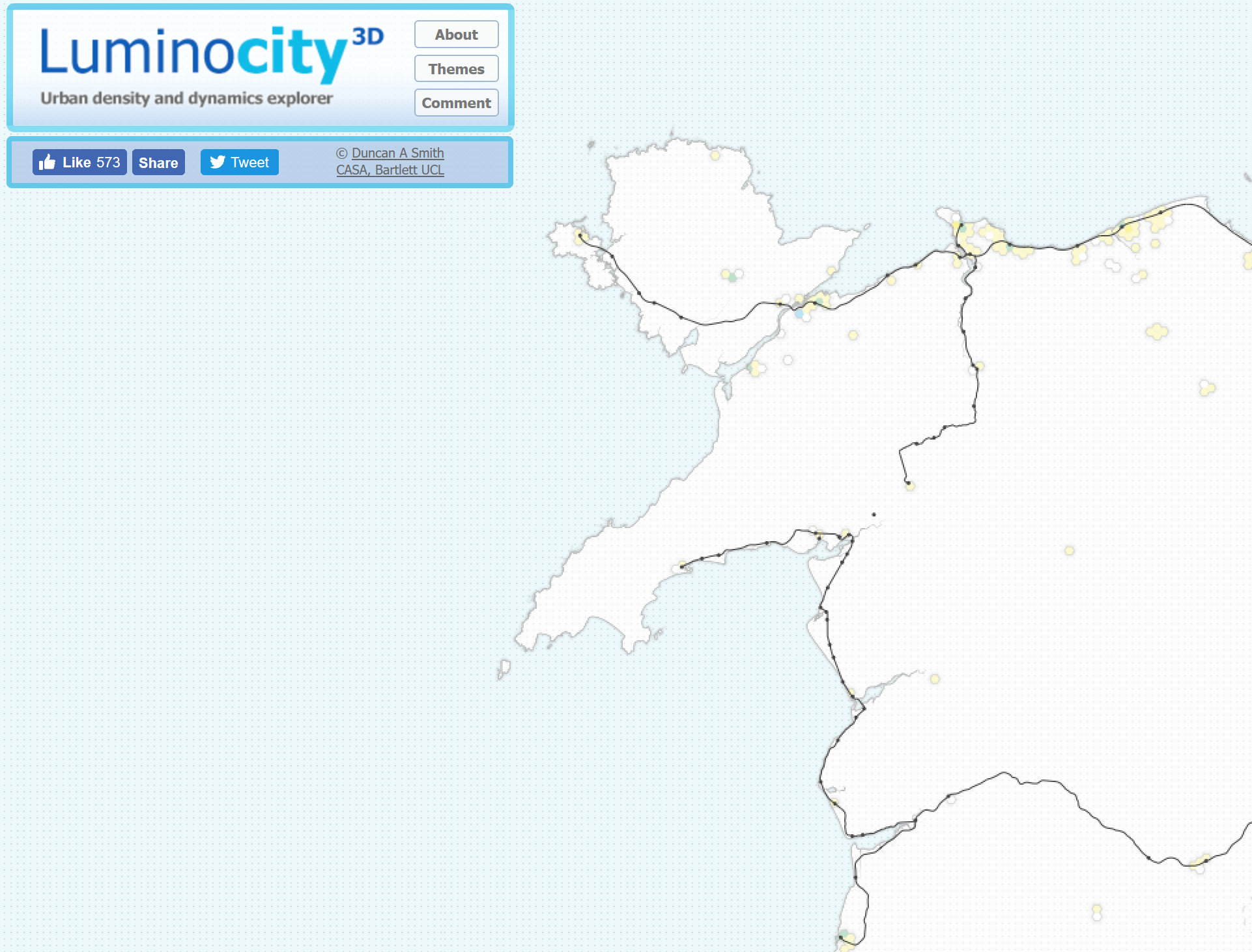
Figure 8 Rail Network in North West Wales
In considering a public transport service that provides a viable alternative to the car (rail, bus and active travel) I think we have to consider
- Faster connections in/out/across the region
- more “all stop local rail services” which given lower population and density needs to reflect demand profile
- Enhanced integration with bus services to connect rural and more isolated communities to the rail backbone
- Enhanced connectivity to key employment sites
Much more detail of the challenges and issues have been set out in the North Wales Joint Local Transport Plan[vii].
Clearly, the demographic profile is challenging when trying to deliver new rail services and new infrastructure and business cases are difficult to justify given lower demand and higher costs (capital and operating costs) associated with traditional Heavy Rail.
So what could we consider?
How about a new and innovative, “medium distance tram-train” service from Amlwch to Dolgellau Figure 9 which also connects Bangor, Caernarfon and Porthmadog. This would use a combination of existing HR rail, old alignments and some new sections, new signalling, passing loops, as well as new stations. This would be a ~120km route providing connections to all stops using a tram-train vehicle specifically designed for medium distance routes such as this (toilets, higher proportion of seats, etc). Much of the route is already in place via the existing HR network or based on disused, but still available, alignments (e.g. to Amlwch); some sections will be more challenging (e.g. Bangor-Caernarfon-Porthmadog and Barmouth-Dolgellau) but not impossible.
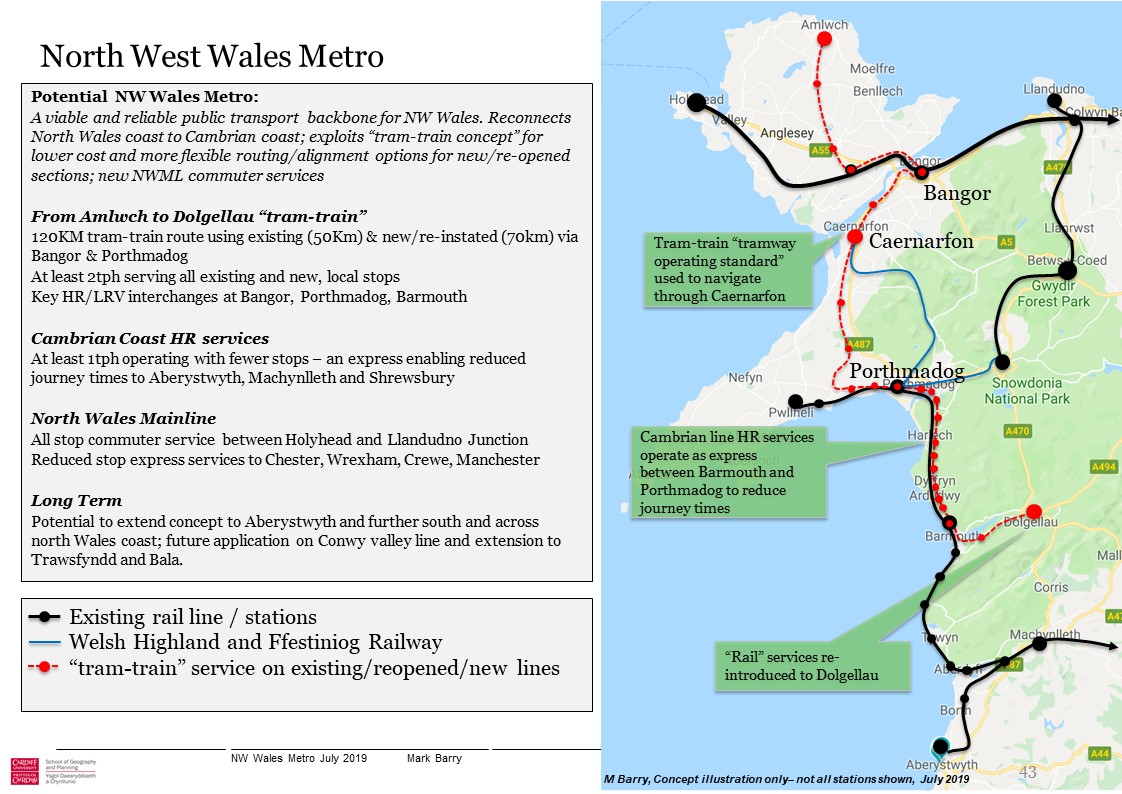
Figure 9 Illustration of possible North West Wales tram-train service
I anticipate very few people would travel the entire route; rather I would expect different cohorts of passengers to use different sections (e.g. Bangor-Caernarfon, Caernarfon-Porthmadog, etc). All this would all need to be modelled to develop a programme that could even be phased with I think the Bangor-Barmouth section adding the most “value”. There are probably several variations that can be tested in a more formal scheme development programme.
Adopting a “tram-train” will enable us, where appropriate, to avoid a more traditional and costly HR approach and present more affordable route/alignment options for the new/re-instated sections. For example, with some signalling innovation, tram-train and Welsh Highland rail services could use the same rail alignment approaching Caernarfon from the south – with the tram-train navigating through to the north of the town and toward Bangor, by using a combination of the original rail alignment and new sections.
My 2018 PSOC work for WG[viii] identified a need for the NWML to be upgraded to support faster long distance services and new local “all stopper” commuter services between Holyhead and Llandudno. We can apply the same model now to the Cambrian Coast line as these proposals would allow the Cambrian coast service to become express (non-stop) between Porthmadog and Barmouth saving significant journey times to Machynlleth and Shrewsbury.
Once in place there is the opportunity to extend further south to Aberystwyth, use of tram-train on the Conwy line may enable an extension to Bala, etc.
More strategically, following WG Bus franchising measures[ix] we can seek to better integrate bus services into the “rail backbone” to provide a more joined up service across the region. The potential for “demand responsive transit” to be integrated into the overall public transport offer could really begin to provide an alternative to car use – even in rural areas.
Carmarthen (or Swansea?) to Aberystwyth
I think a similar approach could allow a more viable rail route to connect Swansea Bay to Aberystwyth using a combination of the old alignment and new sections Figure 10 . I assert it would be better to try and connect south Wales to Aberystwyth via an upgraded Heart of Wales (HoW) Line and offer faster and more frequent services between Aberystwyth and Swansea/Cardiff (rather than Carmarthen – sorry!).
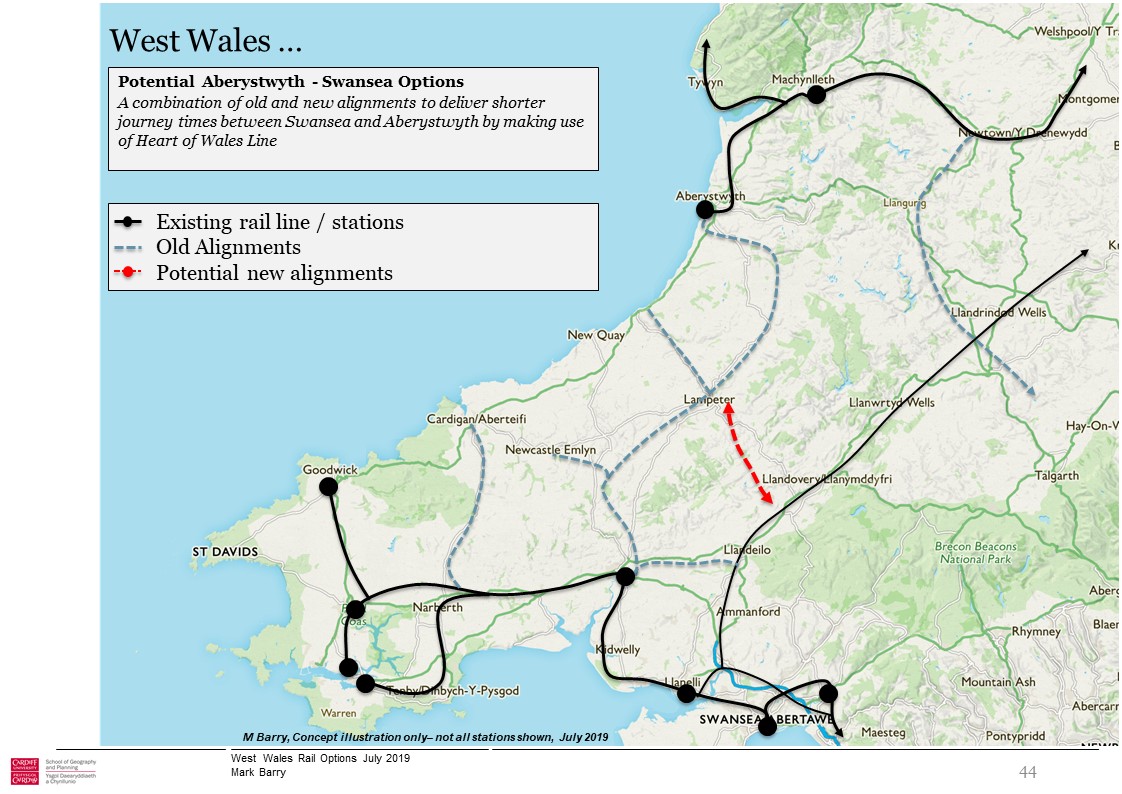
Figure 10 West Wales Options….
It may be possible to achieve this by constructing a new alignment from the HoW line (between Llandeilo and Llanwrda) to the original Aberystwyth – Carmarthen route near Lampeter and then on the old alignment toward Aberystwyth itself. The adoption of a “tram-train” approach may allow more flexibility in route/alignments choices into Aberystwyth itself – as well as offering perhaps a lower capital cost solution.
This would provide a much shorter and faster route between Aberystwyth and Swansea/Cardiff – and so secure a bigger market and fare box which is a material consideration.
It should be noted the recent WG feasibility study[x] was based on pure a Heavy Rail approach focussed on the old alignment. In my view this would be too costly to build with a very high operational cost and subsidy requirement. We have to be more innovative!
In the short term maybe we should try running a more frequent rail service fast from Cardiff to Llanwrda with a bus connection to continue onto Lampeter, Aberaeron and then Aberystwyth. This would deliver a much shorter journey time than would be possible with a re-opened Aberystwyth-Carmarthen railway and help build the demand required for a full “rail solution”?
What next?
Clearly these are just “ideas”. Yes it will cost and require innovation, new infrastructure, signalling, etc and of course, subsidy. But I think it is worth a look, especially given that a more traditional and costly HR approach will be very hard to justify and in reality, in most cases will be undeliverable.
Post Script
28th July….the post generated a lot of comments…
Yes I know it will be difficult, I know the Cambrian Coast line is single track, I know there are bus services, I know it’s not a Metropolitan area and so using the word Metro is slightly misplaced, etc.
This may or may not work….the point I was making is that a pure, traditional Heavy Rail approach to extensions in this part of the world is almost certainly undeliverable. That’s why I “postulated“ a medium distance tram train to allow different and lower cost standards to be developed and applied. This still may not be enough to make the case…..but no-one has actually appraised or tried to quantity such an approach or what an optimal scheme (s) might look like. If you/we want to give up now and say, “its too hard, it wont work, etc” so be it. I think north west Wales deserves better…
[i] https://tfw.gov.wales/journey-begins
[ii] https://swalesmetroprof.blog/2018/06/04/making-metro-work-for-valleyscardiff/
https://swalesmetroprof.blog/2018/12/13/south-wales-metro-lloyd-george-avenue/
https://swalesmetroprof.blog/2019/07/05/a-cardiff-crossrail/
[iii] https://en-gb.topographic-map.com/maps/c4/Wales/
[iv] http://luminocity3d.org/indexRetina.html?duplicate=0#activity_density_mix_2011/8/52.601/-3.664
[v] https://swalesmetroprof.blog/2019/04/25/transit-oriented-development-in-the-cardiff-capital-region/
[vi] https://www.stadlerrail.com/media/pdf/2016_0922_media_release_citylink_chemnitz_innotrans_en.pdf
[vii] https://www.flintshire.gov.uk/en/PDFFiles/Planning/LDP-evidence-base/Local/North-Wales-Joint-Local-Transport-Plan-2015.pdf
[viii] https://swalesmetroprof.blog/2018/12/12/wales-rail-network-the-case-for-investment/
https://gov.wales/sites/default/files/publications/2018-12/the-rail-network-in-wales-case-for-investment.pdf
[ix] https://gov.wales/written-statement-update-public-transport-wales-bill-and-wider-bus-reform-agenda
[x] https://gov.wales/aberystwyth-carmarthen-rail-reinstatement-feasibility-study

I like the idea of adding some faster services on the Cambrian coast line, although my thinking was that these would run through from Porthmadog to Bangor via Caernarfon. Even with heavy-rail standards, getting through Caernarfon looks fairly straightforwarded compared to Carmarthen-Aberystwyth and the Welsh Highland Railway already has a little intergration with the Cambrian’s ETCS signalling at the flat crossing. The experience from developing the latter should help when it comes to sharing the route south from Caernarfon. The most difficult part is probably the topography between Porthmadog and Bryncir where a new route would be needed to avoid the long detour via Afon-Wen that would result if you followed TrawsLinkCymru’s approach of rebuilding what existed previously. Solve that and you could create a fast through link between Mid Wales (Newtown/Machynlleth) and Bangor.
LikeLike
This is a fascinating idea. I’ve often wondered if there might possibly be merit in the idea of applying a smallish government subsidy to the Ffestiniog and Welsh Highland railways to reduce fares and operate more frequent, year-round (when safe to do so) services. I imagine something like three hourly service patterns: (1) all stops Porthmadog Harbour to Blaenau, (2) all stops Porthmadog (WHHR) to Caernarfon, and (3) semi-fast Blaenau to Caernarfon, calling only at stations with passing loops (and Porthmadog Harbour, of course). This would obviously require significant upgrades to the Welsh Highland Railway to increase line speed to 25mph along the whole line (except at dangerous curves, of course), and extra passing loops to allow for half-hourly service on both lines. I think that, on the Ffestiniog side, the journey by rail is only slightly slower than by bus, even with the low line speed (something like 55 minutes by rail vs 40 minutes by bus?), and, while the Welsh highland would never be able to compete with the 1R from Caernarfon to Porthmadog (or your tram-train) directly, it is somewhat time-competitive for Porthmadog to Beddgelert, and, when considering the uncoordinated transfers between the S4 and the S97 buses, is significantly faster (again, despite its painfully slow line speed) from Porthmadog to Waunfawr. This doesn’t take into account driving, but other interventions such as strong marketing and banning non-residents from driving within the National Park in the name of mitigating environmental impact would help on that end.
Longer term, some upgrades to tracks might allow for slightly faster service (30mph might even be sufficient), and perhaps an extension to Llanberis alongside roads and on abandoned railway lines to really. This is obviously on a much smaller scale than the tram-train you describe in this article, and perhaps is more about serving the tourism industry than the region as a whole, but I’d imagine them working in tandem. A narrow-gauge-steam “Metro” may sound ludicrous, but if the infrastructure is there and functioning relatively well, why not use it to its fullest potential? Transport for Wales seems to consider the Ffestiniog Railway to be a valuable enough rail link to include it on their rail map.
LikeLike
Glad you mentioned Llanberis… I still think heavy rail is the right approach for linking Bangor – Caernarfon – Porthmadog – Barmouth – Machynlleth. With a journey time of several hours, the levels of comfort (and toilet provision) provided by a high-quality regional train* such as a class 158 or class 175 are essential. However, there is merit in thinking outside the box, such as Prof Barry’s suggestion of using tram-trains in a non-metropolitan area. Connecting Caernarfon to Llanberis (perhaps with through running to and from Bangor) could I think be a very-good use for light-rail technology.
* the new class 197 units, with hard ‘interrogation centre’ seats and just one toilet per 2-car unit or 2 toilets on a 3-car unit, are sadly NOT high-quality regional trains and are NOT suitable for most of the routes TfW intend to use them on.
LikeLike